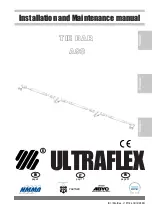
4.3.4
PROBES
Reference 2.1.6, sub-para 2, GATE OUT.
4.3.5
PRELIMINARY
PROCEDURE
1. With the instrument disconnected from the power supply,
remove the cabinet sidesas detailed in 4.2.2.
2. Insert the voltage-selector plug in the rear panel with the
arrow indicating the nominal voltage of the local A.C.
supply or the nearestvalue to it.
3. Connect the Oscilloscope's power cable to a Variac. The
cores of the cable are alternatively colour-coded asfollows.
---:-:-:-:-n--
~
NE~::AL
Black
-I
White
---------------------------
EARTH
(Chassis)
Green/Yellow
Green
4. Set all preset pots to mid position.
5. Set front-panel controls as follows:
POSITION (CHl & 2)
Central
OFF-ON
(CHl
&
2)
OFF
ALL VARIABLES
fully clockwise
STABILITY
fully clockwise
POSITION (horizontal)
Mid position
FINE
Central and pushed in
All push buttons
Out
6. Connect voltmeter; negative to CRT pin 2, positive to
earth.
7. Connect the Variac to the power supply, switch on power
supply and allow oscilloscope to warm up.
8. Adjust
the
Variac to
give the same voltage as that
indicated by the voltage-selector plug.
9. Adjust BRI LLlANCE for reasonablesetting.
10. Adjust FOCUS and ASTIG.
11. Adjust R308 to give voltmeter reading of -3200V.
12. Turn BRILLIANCE fully clockwise.
13. Adjust R328 for maximum brilliance.
NOTE When R328 is correctly adjusted, the BR I LLlANCE
control should give continuous variation over its range.
Over adjustment of R328 simply causesexcessive spot
swelling with no real increase in the trace brilliance. Also
the EHT may change, as indicated by avometer.
14. Adjust BRILLIANCE for reasonablesetting.
15. DepressBEAM LOCATE and observespot appearsappro-
ximately 2mm to the left of the trace start.
1.0
To set auto and trigger sensitivity R17 and R34.
1.1
Set VARIABLE
(speed)to EXT X.
1.2
Releaseall Buttons.
1.3
PressEXT TRIG.
1.4
Set CHl and CH2 DC-GND-AC to GND.
1.5
Connect
TEST
Oscilloscope to TR3 collector
tag
62.PCll0.
(Reference Fig 11)
1.6
Set Oscilloscope to 0.1 volts/div and 20 ms/dil/.
1.7
Turn R34 fully anti-clockwise.
1.8
Adjust R17 to the centre of the range over which a
continuous
oscillation,
at
1 MHz approximately,
is
observed on the Test Oscilloscope.
1.9
Turn R34 slightly clockwise.
1.10
Reset R17 to the centre of the oscillation range.
1.11
Repeat 1.7 through 1.9 until the oscillation develops
into a triangular waveform at 20 Hz approx.
1.12
Adjust R17 and R34 to give a symmetrical waveform
of 70 mV peak to peak.
2.0
To set gate potential: R93.
2.1
Connect Test Oscilloscopeto Tag 21, PCll0.
2.2
Turn STABILITY fully anti-clockwise.
2.3
Turn VARIABLE
(speed)fully clockwise.
2.4
Adjust R93 for 2 V negative potential with respect to
GND.
3.0
To set sweep length: Rl06.
3.1
Connect Test Oscilloscopeto Tag 23, PCll0.
3.2
Turn STABILITY fully clockwise.
3.3
Adjust R106 for a total sweepamplitude of 10 V.
3.4
Disconnect Test Oscilloscope.
3.5
ReleaseEXT TRIG.
3.6
Set CHOP-SUM-ALT to AL T.
4.3.7
VERTICAL AMPLIFIER (supply variation compensation)
1.0
To set CH1 supply variation: CH 1 on, CH2 off.
1.1
Set VOLTS/DIV to 10 mY.
1.2
Set DC-GND-AC to DC.
1.3
Connect Calibrator to INPUT 1.
1.4
Set calibrator to 5
m\l
peak to peak, 1 kHz squarewave.
1.5
PressVARIABLEforXl0gain.
1.6
Set POSITION to centre of range.
1.7
Adjust R642 until trace appears.
1.8
Set R618 for 5 div deflection approximately.
1.9
Adjust STABI L1TY for free-run trace.
1.10
Set DC-GND-AC to GND.
1.11
Adjust R642 to centralize trace.
1.12
Reducesupply voltage by 10%.
1.13
Note direction. if trace movesin the vertical axis;
1.14
Adjust R622 slightly to move trace in the direction
noted in 1.13 above.
1.15
Increase supply to normal.
1.16
Adjust R642 to :;entralize trace.
.17
Rel'eat 1.12 th'ough
1.16 until trace movement is
reduced to a minl!!1um, when the Variac setting is varied
between
±
10%,
2.0
To set CH2 supply variation: CHl off, CH2 on.
2.1
SetVOLTS/DIVtol0mV.
2.2
Set DC-GND-AC to DC.
2.3
Connect Calibrator to INPUT 2.
Summary of Contents for DM64
Page 1: ...PAHAMQELIAJP KO EHHKO KLA OPKN CA cUBA I31 I JQ H ...
Page 32: ......
Page 62: ......
Page 63: ......
















































